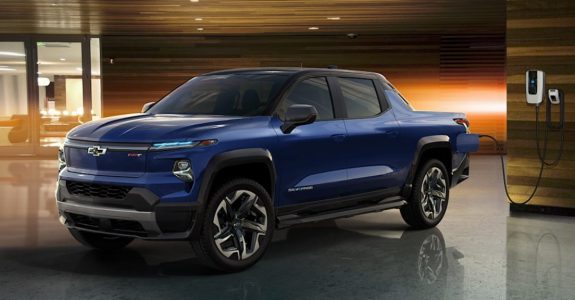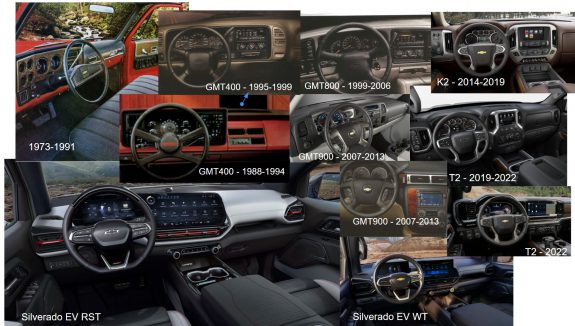2024 Silverado EV Design Critique
The upcoming 2024 Chevrolet Silverado EV has the potential to be one of the key vehicles that helps transition the industry towards electrification. With Ford’s full-size F-150 winning the sales crown decade after decade, the electrified trucks likely have the best chance of success to sell in large volume. Taking a significantly different approach than Ford’s F-150 Lightning, the Silverado EV shares pretty much only the name with its conventional internal combustion counterpart. Plenty has already been written about vehicle range and how the F-150 and Silverado EV stack up towards one another. What we’d like to focus on is what a dramatic shift this EV’s styling is for Chevy trucks.
Chevrolet has announced three familiar trim levels; the spartan Work Truck (designated WT), the street smart and feature laden RST, and the off-road capable Trail Boss. While the current generation T1-based internal combustion powered Silverado made a strong effort to play up its Chevrolet heritage at its 2019 model year debut, the newly updated 2022 Silverado strays from the two-tiered grille and headlight styling that has been a Chevy truck mainstay since the 1980s. Indeed, the 1988 full-size Chevrolet trucks were perhaps the perfect interpretation of the look, though the 1999 GMT800 successors were well polished updates to the design language. While subsequent facelifts and full redesigns have tried hard to capture the look pioneered by the 1988 trucks they have never looked as pure or as coherently styled. This is one of the reasons the Silverado EV is so significant. This electric truck is the opportunity Chevy stylists needed to rethink truck styling altogether.
The EV configuration has freed Chevy designers and engineers to make use of the area under the front hood that we’ll join the interwebs in calling a frunk. We’re confident the designers weren’t inspired by the original Chevy-with-a-frunk, but one can’t help but notice some similarities. The 1960 Corvair mimicked the VW Beetle’s powertrain layout by placing an air-cooled engine in the back, but Chevy styled the car completely differently than the “Bug.” Embracing the freedom granted by having no radiator at the front, the Corvair had a clean faced looked with a significant full width brow above the headlights and a free-standing Chevrolet logo and shield placed neatly between the headlight pods. 1961 saw that clean panel reshaped from concave to convex allegedly to create just a little more frunk volume. The crisp, convex, clean nose of the Silverado EV and the 1961 Corvair bear a subtle, if coincidental, family resemblance. Certainly, the styling of both vehicles was shaped by the luxury of having no powertrain in the front dictating traditional styling cues.
The WT continues the Chevy truck tradition of featuring vast amounts of flat black plastic which debuted on the new de-contented W/T 1500 way back in 1990. Like the inaugural W/T 1500 the EV WT features painted steel rims, gold Chevy emblems, and unadorned body panels, but thankfully omits the budget minded seal beam headlamps. Following in the tradition of featuring more basic content, the WT doesn’t offer the RST’s mid-gate nor full width light bar.
On the inside, both the RST and WT Silverado EVs return to a driver-oriented instrument panel. This is a return to form for Chevrolet trucks. The then-new 1973 trucks greeted operators with an instrument panel that angled all major controls towards the driver. Each successive generation of Chevrolet trucks continued that functional and visual tradition all the way up until the debut of the K2 platform Silverado of 2014 which moved major controls to a central stack. It is notable that the optional instrument panel in the GMT900 also completely abandoned the driver focused pod-like design, but a more traditional dash was found on certain configuratoins. The Silverado EV takes the driver-focused theme and modernizes it with large free-standing screens. The RST has a beveled look while the WT simplifies the screen with right angles and smaller surface area. No word on old-school bench seat availability, but the center console looks like it isn’t married to the instrument panel, nor does it house any necessary controls so we wouldn’t be shocked if the traditional bench makes an appearance on the option sheet.
In all, this Silverado EV has stepped up to the plate ready to offer the world a truly modern pickup truck. Like the Ford Lightning, it hits at the heart of the largest vehicle segment but manages to pull some old tricks out of its sleeve, primarily making use of the long-lamented Avalanche body style with mid-gate. While the Ford manages to electrify an otherwise perfectly conventional pickup truck, Chevrolet has attempted to truly reinvent it. Ford claims 300 miles of range, while Chevy is boasting 400 miles, though we’ll need to wait for the EPA to rate the Chevy before a true comparison can be made. We expect both will be largely successful, but it is nice to see two competitors offering very different answers to the same question. Regardless of which approach you prefer, there is no doubt that the full-size truck wars continue to charge forward.












